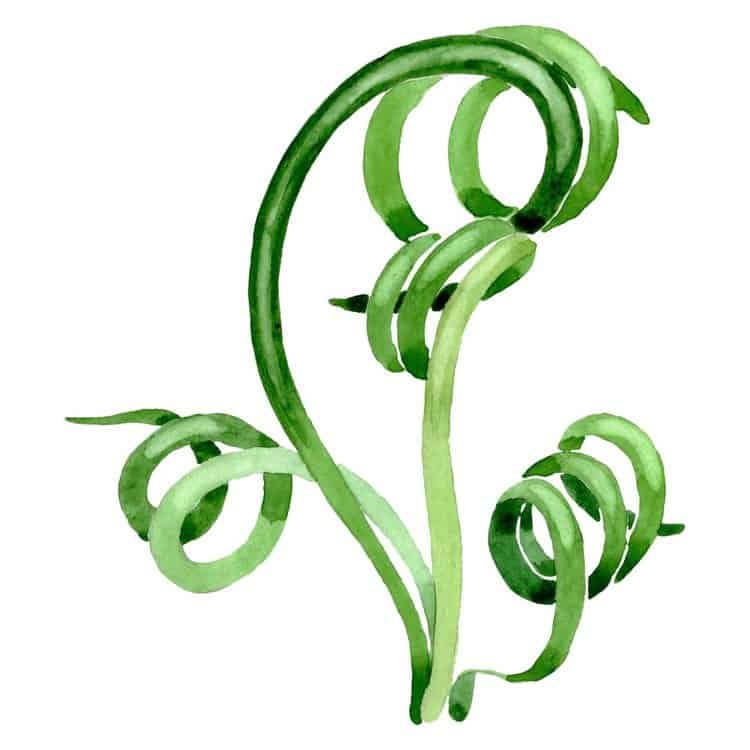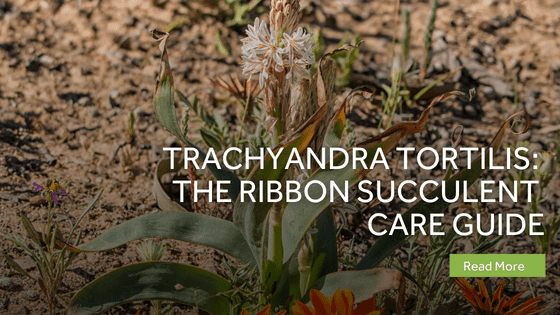Are you looking for a bizarre and unique plant for your space? Look no further than the spiral leaves of the Trachyandra tortilis plant. This species is bound to impress with its curly foliage and vibrant green color. Read on to learn how to expertly care for this amazing plant!
Table of Contents
Trachyandra Tortilis Overview
The Trachyandra tortilis is an unusual succulent species with a long life span. This species is native to South Africa and Madagascar and is part of the genus Trachyandra, first reported in 1843. The Trachyandra genus includes plants with filiform and linear succulent leaves.
The Trachyandra tortilis belongs to the Asphodelaceae family, also known for being home to the popular Aloe Vera plant. This gorgeous and small plant is also known as the “ribbon plant” due to its spiraling and curling linear leaves.
Other premier Trachyandra varieties include the Trachyandra falcata, Trachyandra saltii, and the Trachyandra hirsutiflora.
Trachyandra falcata: This species prefers sandy or clay flats, has four to five linear basal leaves, and produces mauve and white flowers.
Trachyandra saltii: This Trachyandra variety is found in grasslands in tropical areas and produces white flowers and grassy leaves.
Trachyandra hirsutiflora: The hirsutiflora has grey and white flowers and long stem pedicels on lower slopes and sandy flats.
| Botanical Name | Trachyandra tortilis |
| Family | Asphodelaceae |
| Genus | Trachyandra |
| Origin | South Africa and Madagascar |
| Sunlight | Bright indirect light |
| Watering | Moderate |
| Soil | Sandy, well-draining, and aerated |
| Temperature | 41-59 degrees Fahrenheit |
| Propagation | Leaf cuttings |
| Re-Potting | Once seriously rootbound |
| Pests and Diseases | Mealy bugs |
| Toxicity | Nontoxic to humans and pets |

Trachyandra Plant Features
The Trachyandra tortilis is a rare plant known for its beautiful spiraling leaves. The curly, ribbon-like foliage can grow up to 25 inches tall. On average, a mature leaf will grow about 10-15 cm tall and about 8 cm wide.
This species does produce beautiful flowers, but it is a rare sight. These blooms only last less than a day, so don’t blink! If you are lucky enough to catch the blooming, you will see soft pink blooms with green patterning during the late winter and early spring. Another bonus of growing this plant indoors is its nontoxic nature of the plant.
Ribbon Plant Care Guide
Caring for Trachyandra tortilis can be very challenging for those just getting started with plants, but read on to learn more and become an expert. The Trachyandra tortilis plant differs from other succulent plants regarding the growing season, temperature range, and watering requirements.
This species prefers bright indirect light, moderate watering, and low humidity. Trachyandra tortilis plants grow best in sandy, well-draining soil with a rich, succulent potting mix. This plant can be challenging for novices also because of the lower temperature requirements.
Ideal Growing Place
The Trachyandra tortilis plant can be grown outdoors in the right climate conditions. However, most people prefer to add this species to their indoor succulent collection. It is much easier to control the growing conditions indoors and create a thriving environment for your plant.
This Trachyandra species is a rare plant with a unique growing season compared to other plants we know and love. The growing season occurs in the middle of fall, winter, and spring. We can see the lovely blooms appear in late winter. Summer brings the dormancy period.
Water
A common method for watering the Trachyandra tortilis is the tried and true “soak and dry” strategy used with many succulent plants. To do this, water heavily, get the soil completely soaked, and allow the soil to dry. Water again once the soil has dried completely.
During the growing season, your Trachyandra tortilis plant will likely need to be watered about once per week. Once dormancy approaches in the summer, reduce watering to about once or twice a month.
This species does not fare well with overwatering and wet soil surfaces. Too much excess water near the roots leaves your plant at risk for harmful root rot.
Sunlight
Like many others, this succulent thrives on bright indirect sunlight. Place your plant near a well-lit window to receive at least six hours of indirect sunlight daily. Too much direct sunlight can harm your plant’s beautiful leaves as it can scorch them.
Temperature
A tricky part of Trachyandra tortilis care is the temperature range in which it grows best. This succulent species prefers a temperature range of 41-59 degrees Fahrenheit. Unfortunately, for those growing your plants indoors, this temperature may not align with your space’s temperature. The good news is that your plant can adapt to higher temperatures but is sensitive to the lower temperatures outside of that range.
Soil
A sandy, well-draining soil is best for the Trachyandra tortilis plant. The environment should mimic the plant’s native home, as does the well-draining sandy soil qualities. Ensure your plant pot has drainage holes to help excess water flow out. This can help avoid dangerous root rot.
Trachyandra tortilis plants prefer a common succulent potting mix with amendments like perlite, rocks, and sand. These additions can help your roots because the air circulates freely in the soil.
Humidity
Humidity levels should be kept low for the Trachyandra tortilis plant. This species fares best in an environment with 50% humidity or below. Too much excess moisture can lead to fungal disease of the foliage or encourage root rot.
Fertilizer
Providing fertilizer for your Trachyandra tortilis is not always necessary since it is slow-growing, and soil can often provide the needed nutrients. If you would like to boost your plant, give a liquid organic fertilizer at half-strength only once or twice a year and only during the winter.
Pinching/Pruning
This species does not need to be pruned, as it has slow growth, and the leaves are curling and spiraling upwards at a slow rate. You can, however, prune up the roots when repotting your plant if they are getting too large.
Potting and Re-potting
Experts suggest repotting your houseplants about once per year, which is a great chance to check on your Trachyandra tortilis plant root system. To repot, gently remove your plant from the pot and shake excess soil out. Then, inspect your roots, and prune any if you wish.
Then, place fresh growing mixture soil into the new pot, settle the roots, and lightly water the plant. The plant will then settle into its new home, which may take a few days for adjustment.
You May Also Like: Should You Go Organic With Your Garden
Growth Zone
The Trachyandra tortilis plant grows outdoors in the USDA Plant Hardiness Zones 9-11. These areas along the west coast and southern states have the proper climate to support the growing conditions for this succulent species.
Common Pests, Toxins, Diseases & Other Problems
Trachyandra tortilis plants are resistant to many houseplant pests but can be affected specifically by mealy bugs. If you find cottony, white balls on your plant leaves, that is a sure sign that mealy bugs are feeding on your plant. You can treat this by wiping the leaves with neem oil or soft soapy water-soaked cotton balls.
Trachyandra Tortilis Propagation
You can propagate your Trachyandra tortilis plant in two ways: leaf cuttings and Trachyandra seeds. Growing Trachyandra tortilis from seeds is a very difficult and time-consuming task, taking three years or more to see any significant growth. Therefore, most people opt for leaf-cutting propagation.
To propagate using leaf cuttings, find a healthy growth, a plump leaf with no discoloration. Cut it as close to the base stem as possible using sterile scissors or a sharp knife. Let this cutting dry for four to five days, after which it should be calloused on the bottom.
Place this cutting into the fresh potting mix and let it sit for a few more days. After at least three days, you can lightly water the cutting and let the soil dry again before the next watering. Repeat until you see new root growth!
Trachyandra Tortilis Mature Timeline
After propagating by leaf cuttings, your cutting will begin sprouting new root growth in about a month. Once your new plant roots are strong and long enough, you can plant them in a bigger container!

Trachyandra Tortilis FAQ
How Big Does the Trachyandra Plant Get?
The Trachyandra tortilis plant grows about 10-15 cm tall, spiraling leaves about 8 cm wide.
Where to Buy Trachyandra Tortilis Plant?
Online commerce sites like Etsy and eBay are selling propagated Trachyandra tortilis plants. You can also find websites for succulent nurseries that are selling this plant.
Where Can You Get Trachyandra Tortilis Seeds?
Online nurseries sell Trachyandra tortilis seeds and can ship them directly to you.
How Long Does It Take to Grow Trachyandra Tortilis From Seeds?
Growing a Trachyandra tortilis plant from seeds can take at least three years to see significant growth and take even longer if you wish to see your plant mature.
Is It Hard to Grow Trachyandra Tortilis From Seeds?
Growing your Trachyandra tortilis from seeds is a difficult and time-consuming task. Propagating by leaf cuttings is an easier method and is preferred by many.
What Are the Most Common Problems With Trachyandra Tortilis?
The most common issues with the Trachyandra tortilis are root rot from overwatering and mealy bug infestations.
When Should Trachyandra Tortilis Be Planted?
If you want to plant or repot your Trachyandra tortilis, the best time is during the winter growing season.
Is Trachyandra Tortilis Rare?
The Trachyandra tortilis is a rare beauty and one of many coveted exotic plants. This species is sought after due to its rarity and long lifespan.
Is Trachyandra Tortilis Trees Toxic or Poisonous to Cats, Dogs, and Humans?
The Trachyandra tortilis is a nontoxic succulent for humans and animals, but it is still recommended to keep this plant away from children and pets.
Do I Have to Clean My Trachyandra Tortilis?
Cleaning the leaves of your Trachyandra tortilis is recommended to help keep harmful insects like mealy bugs from moving in and get rid of any excess moisture that may be resting on the foliage.
The Bottom Line
While the Trachyandra tortilis plant can be challenging to care for, many love its longevity, unique beauty, and dainty size. Adding this species to your collection will add fun shapes and colors to your plant dynamic. By following the Trachyandra tortilis care guide, you will become an expert in this species and provide quality care for years to come!
Last Updated on August 27, 2022 by Gustaf Johansson




